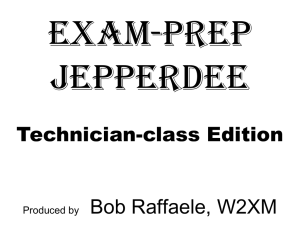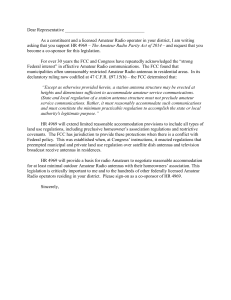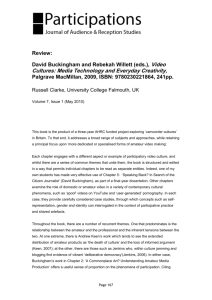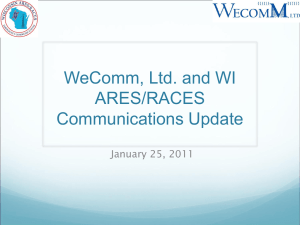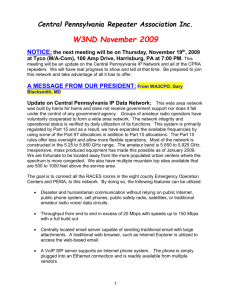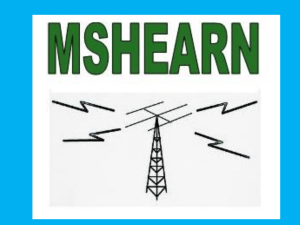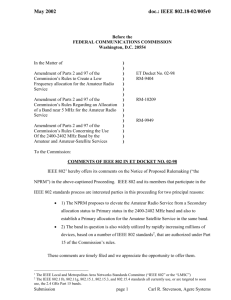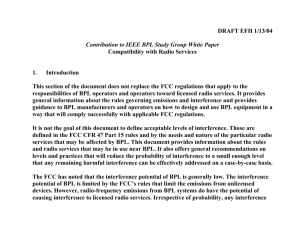Doc 9 - Cept
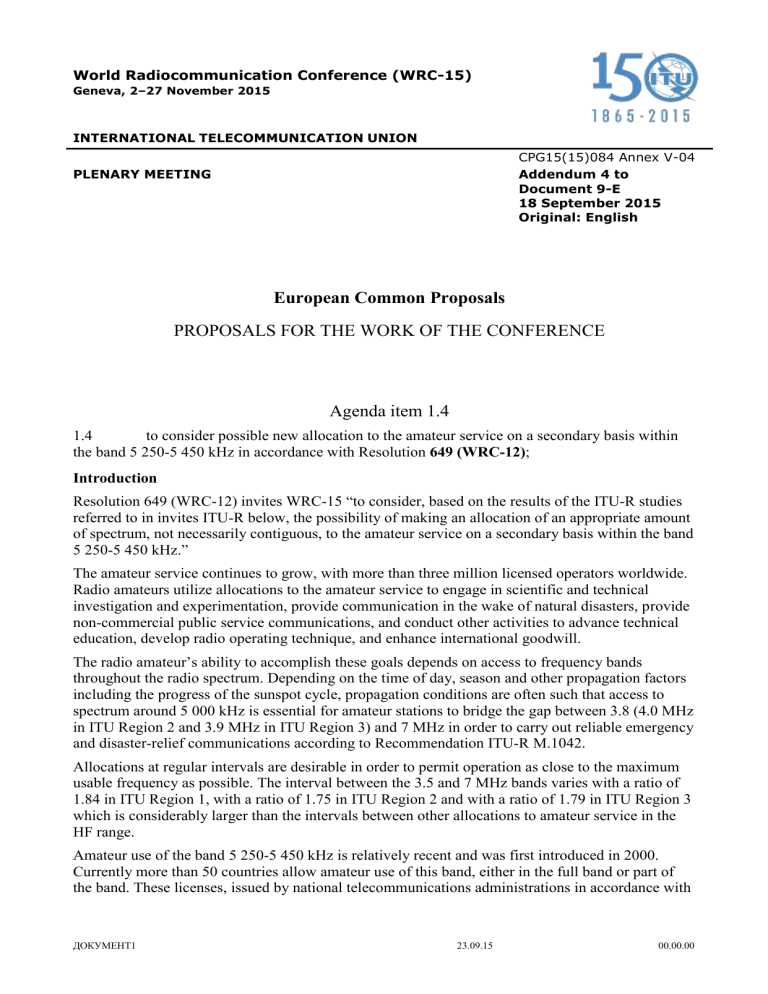
World Radiocommunication Conference (WRC-15)
Geneva, 2–27 November 2015
INTERNATIONAL TELECOMMUNICATION UNION
PLENARY MEETING
CPG15(15)084 Annex V-04
Addendum 4 to
Document 9-E
18 September 2015
Original: English
European Common Proposals
PROPOSALS FOR THE WORK OF THE CONFERENCE
Agenda item 1.4
1.4 to consider possible new allocation to the amateur service on a secondary basis within the band 5 250-5 450 kHz in accordance with Resolution 649 (WRC-12) ;
Introduction
Resolution 649 (WRC-12) invites WRC-15 “to consider, based on the results of the ITU-R studies referred to in invites ITU-R below, the possibility of making an allocation of an appropriate amount of spectrum, not necessarily contiguous, to the amateur service on a secondary basis within the band
5 250-5 450 kHz.”
The amateur service continues to grow, with more than three million licensed operators worldwide.
Radio amateurs utilize allocations to the amateur service to engage in scientific and technical investigation and experimentation, provide communication in the wake of natural disasters, provide non-commercial public service communications, and conduct other activities to advance technical education, develop radio operating technique, and enhance international goodwill.
The radio amateur’s ability to accomplish these goals depends on access to frequency bands throughout the radio spectrum. Depending on the time of day, season and other propagation factors including the progress of the sunspot cycle, propagation conditions are often such that access to spectrum around 5 000 kHz is essential for amateur stations to bridge the gap between 3.8 (4.0 MHz in ITU Region 2 and 3.9 MHz in ITU Region 3) and 7 MHz in order to carry out reliable emergency and disaster-relief communications according to Recommendation ITU-R M.1042.
Allocations at regular intervals are desirable in order to permit operation as close to the maximum usable frequency as possible. The interval between the 3.5 and 7 MHz bands varies with a ratio of
1.84 in ITU Region 1, with a ratio of 1.75 in ITU Region 2 and with a ratio of 1.79 in ITU Region 3 which is considerably larger than the intervals between other allocations to amateur service in the
HF range.
Amateur use of the band 5 250-5 450 kHz is relatively recent and was first introduced in 2000.
Currently more than 50 countries allow amateur use of this band, either in the full band or part of the band. These licenses, issued by national telecommunications administrations in accordance with
ДОКУМЕНТ1
23.09.15 00.00.00
2
CMR15/-E
Article 4.4 of the ITU Radio Regulations, have not led to harmful interference to radiocommunication services operating in this frequency band.
European monitoring results show that less than 20% of the band 5 250-5 450 kHz is used by stations in the fixed and mobile service (except aeronautical mobile), indicating that a secondary amateur allocation in this band should be feasible without causing harmful interference to the primary services.
The frequency band 5 250-5 275 kHz is allocated to the radiolocation service on a secondary basis.
According to studies from ITU-R WP 5A sharing conditions between a new secondary allocation to the amateur service and the existing secondary allocation to the radiolocation service in the frequency band 5 250-5 275 kHz will be quite difficult. Therefore it is not proposed to include this frequency range in a new global secondary allocation to the amateur service.
The Table of Frequency Allocations shows that the frequency band 5 250-5 450 kHz is allocated to the fixed and mobile (except aeronautical mobile) services on a primary basis. These existing allocations need to be protected.
These European Proposals are proposing a secondary allocation of the band 5 350-5 450 kHz to the amateur service in accordance to Method A2 of the CPM Report.
ДОКУМЕНТ1
23.09.15 00.00.00
3
CMR15/-E
ARTICLE 5
Frequency allocations
MOD EUR/9A4/1
5 003-7 450 kHz
Allocation to services
Region 1 Region 2
…
5 275-5 350
5 350-5 450 FIXED
MOBILE except aeronautical mobile
Amateur
…
FIXED
MOBILE except aeronautical mobile
Region 3
Reasons: To allow access to frequency bands at regular intervals the amateur service requires a band between 3.8 and 7.0 MHz. Despite a large number of MIFR entries, monitoring results show that less than 20% of the band 5 250-5 450 is used by stations in the fixed and mobile services.
Amateur operators have a proven record of sharing spectrum with other services without causing harmful interference.
SUP EUR/9A4/2
Section IV – Table of Frequency Allocations
(See No. 2.1
)
RESOLUTION 649 (WRC-12)
Possible allocation to the amateur service on a secondary basis at around 5 300 kHz
Reasons: Europe proposes to suppress Resolution 649 (WRC-12) since it will become superfluous after the studies are completed and the secondary allocation to amateur service is adopted by WRC-15.
_______________
ДОКУМЕНТ1
23.09.15 00.00.00

